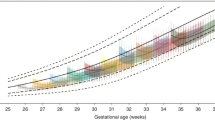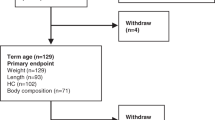Abstract
Postnatal growth retardation appears inevitable in preterm infants. This partly reflects an inability to establish adequate dietary intakes in a timely fashion in the sick, unstable immature infant. However, it may also reflect inherent errors in current recommendation as well as systematic errors in the way nutrient requirements are estimated in these high-risk infants. These issues are addressed in this article.
This is a preview of subscription content, access via your institution
Access options
Subscribe to this journal
Receive 12 print issues and online access
$259.00 per year
only $21.58 per issue
Buy this article
- Purchase on Springer Link
- Instant access to full article PDF
Prices may be subject to local taxes which are calculated during checkout




Similar content being viewed by others
References
American Academy of Pediatrics Committee on Nutrition. Nutritional needs of preterm infants In: Kleinman RE, editor. Pediatric Nutrition Handbook. Elk Groove Village: American Academy of Pediatrics; 1998. p. 55–88.
Embleton NE, Pang N, Cooke RJ . Postnatal malnutrition and growth retardation: an inevitable consequence of current recommendations in preterm infants? Pediatrics 2001;107(2):270–273.
Cooke RJ, Ford A, Werkman S, Conner C, Watson D . Postnatal growth in infants born between 700 and 1,500 g. J Pediatr Gastroenterol Nutr 1993;16(2):130–135.
Carlson SJ, Ziegler EE . Nutrient intakes and growth of very low birth weight infants. Perinatol 1998;18(4):252–258.
Ehrenkranz RA . Growth outcomes of very low-birth weight infants in the newborn intensive care unit. Clin Perinatol 2000;27(2):325–345.
Ehrenkranz RA, Younes N, Lemons JA, et al. Longitudinal growth of hospitalized very low birth weight infants. Pediatrics 1999;104(2, Part 1):280–289.
Clark RH, Thomas P, Peabody J . Extrauterine growth restriction remains a serious problem in prematurely born neonates. Pediatrics 2003;111(5, Part 1):986–990.
Olsen IE, Richardson DK, Schmid CH, Ausman LM, Dwyer JT . Intersite differences in weight growth velocity of extremely premature infants. Pediatrics 2002;110(6):1125–1132.
Cooke RJ, Ainsworth SB, Fenton AC . Postnatal growth retardation: a universal problem in preterm infants. Arch Dis Child Fetal Neonatal Ed 2004;89(5):F428–F430.
Greisen G . Estimation of fetal weight by ultrasound. Horm Res 1992;38(56):208–210.
Author information
Authors and Affiliations
Additional information
Disclosure: No significant relationship to disclose.
Rights and permissions
About this article
Cite this article
Cooke, R. Postnatal Growth in Preterm Infants: Have We Got it Right?. J Perinatol 25 (Suppl 2), S12–S14 (2005). https://doi.org/10.1038/sj.jp.7211310
Published:
Issue Date:
DOI: https://doi.org/10.1038/sj.jp.7211310



